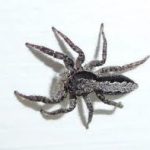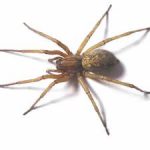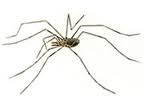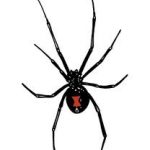Wolf
Habitat: Common household pest in the fall when they are looking for a warm place to overwinter. They are commonly found around doors, windows, house plants, basements, garages, and in almost all terrestrial habitats. They do not spin a web but roam at night to hunt for food. Wolf spiders are often confused with the brown recluse, but they lack the unmistakable violin-shaped marking behind the head. The wolf spider is shy and seeks to run away when disturbed.
Description: Wolf spiders range from about 1/2 inch to 2 inches in length, hairy, and are typically brown to gray in color with various markings or lines. Wolf spider mothers carry their large egg sacs around with them. When the young spiderlings hatch they climb onto their mother’s back and ride around until partially grown. Wolf spiders are not poisonous, though as with all spiders, bites may cause reactions in certain individuals.
Violin
Also known as the brown recluse.
Description:
The name “violin spider” describes a characteristic marking on this animal: there is a violin-shaped patch on the broad, almost heart-shaped cephalothorax (the “head” as opposed to the abdomen). The overall color is usually a grayish-yellow-brown, the oblong abdomen covered with gray hairs. The legs are darker than the body and are long and slim. Females are larger then males. The webs are small, irregular and untidy. These spiders are usually seen walking or running around, not in a web.
Size: Length: females to 1/4 inch, not counting legs; including legs in a typical pose, they are about 1 inch long.
Habitat and conservation: The name “recluse” describes this spider well. It commonly hides in little-used drawers, closets, attics and basement areas, and behind baseboards and furniture. They cannot climb smooth surfaces and are often found trapped in bathtubs and sinks. Their habit of hiding among packed-away garments and towels creates a common situation for human bites, when a person dons clothing from storage without inspecting or shaking it out first. In nature, they live under and in crevices of rocks.
Foods: Dietarily, brown recluses are little different from other spiders. They eat small insects and other spiders. As a running spider (not a spider that uses webs to catch prey), recluses chase down prey like a wolf. The purpose of their venom is to subdue their prey. In fact, brown recluses cannot easily bite humans unless they are pressed against our skin (as when they are suddenly trapped between a garment and our bodies, or if they are exploring our bed sheets and we roll on top of them).
 Jumping
Jumping
Jumping Spider, common name for any of a group of hunting spiders that can leap 10 to 40 times their body length. With over 4000 described species, they comprise the largest family of spiders. Jumping spiders are particularly diverse in tropical regions, but occur in habitats ranging from rain forests to above the timberline on Mount Everest in the Himalayas. More than 300 species have been described in the United States.
Jumping spiders are usually less than 2 cm (less than 0.8 in) in length with females generally larger than males. They are among the most ornate of spiders; many species are brightly colored and strikingly patterned, with stout bodies, short legs, and a very large pair of eyes on the front of the face. The jumping spider has four pairs of eyes, with the large principal eyes giving it sharper vision than any other animal of similar size. It can identify prey, predators, and mates from up to 30 cm (up to 12 in) away.
The jumping spider is an active predator, usually hunting during daylight. It will stalk to within a few body lengths of the prey, crouch, crawl slowly forward, and then lift its front legs and pounce. It accomplishes its spectacular jumps by means of muscular contractions in the body that force body fluids into the legs, causing the legs to extend rapidly. Most jumping spiders feed on insects, while others feed primarily on web-building spiders.
The male’s front pair of legs are colored and have distinctive bands of hair. In many species the male performs complex courtship displays in which he bobs his body and waves his front legs in a highly specific manner. After mating, the female lays her eggs in a silk-lined shelter under stones or bark, or on the surface of plants. The female will often guard the eggs and newly hatched young.
 Hobo
Hobo
The hobo spider is a member of the spider family Agelenidae, a common group that has many species throughout California and the United States. Agelenid spiders can have very dense populations in certain habitats. The members of this family construct a snare referred to as a funnel web, which is a trampolinelike, horizontal web constricting back into a funnel or hole. The web is typically found in a crack between bricks or under wood, stones, or vegetation. The spider waits in the mouth of the funnel for prey to fall onto the horizontal surface, and then it rushes out, grabs the prey, and takes it back to its funnel to consume. If you go outside on a dewy morning, you can often see many of these funnel webs.
The hobo spider shares traits with many of its relatives in the Agelenidae family, including coloration and web-building characteristics. It is a brown spider about 1/4 to 5/8 inch in body length and lives in a funnel web. There are dozens of similar looking spider species in California that build funnel webs, including members of the genera Agelenopsis (2 species), Calilena (13 species), Hololena (21 species), Novalena (4 species), and Rualena (8 species). There is even a unique wolf spider genus, Sosippus (1 species), in California that, unlike its free-hunting relatives, builds a funnel web. Therefore, if you see a funnel web in California, there are many other spiders you should suspect before even considering the hobo spider as a possibility. None of these species causes necrotic wounds or serious injury to humans.
To distinguish funnel-weaving spider species, the arachnid’s reproductive structures must be examined, a task that requires the skills of a qualified arachnologist. Each spider species has a distinctive “lock and key” design of the male and female reproductive organs. Through evolution, the physical features of the males and females have become unique for each species and hence are used by arachnologists for species differentiation. Until someone has examined reproductive features on dozens of hobo spiders and also related species, it is unlikely that a hobo spider would be correctly identified with the naked eye. Therefore, virtually any “hobo spider” identification by a non-arachnologist in California should be suspect.
If you have access to a magnifying device (hand lens, microscope, etc.), there is an easy way to determine if the spider you have IS NOT a hobo spider. First, the spider must be associated with a funnel web; otherwise it could easily be one of the hundreds of other non-agelenid spider species in California. All funnel-weaving spiders have eight eyes arranged in two rows. If you look at the spider head on, however, most of the agelenid spiders in California have their two rows of eyes curved so strongly that it appears that their eyes are actually in three horizontal rows with four eyes in the middle row with two eyes above and two eyes below this row. This is known as the 2-4-2 eye pattern. Exceptions are the spiders of the genus Tegenaria, which have eyes that are in the more common pattern of two rows of four. This is also the most common eye pattern for spiders in general, and unless you remove the spider from a funnel web, it will probably not be a funnel-weaving spider.
Nonetheless, it is not uncommon to find a funnel-weaving spider with two straight rows of eyes in California. There are two species of Tegenaria in the state, T. pagana and T. domestica. Neither species is native to the United States. Their coloration is similar enough to that of the hobo spider, T. agrestis, that anyone except a spider expert might confuse them with the hobo spider. Tegenaria pagana is found in coastal California regions to slightly inland. Tegenaria domestica, however, is an extremely common spider, about 1/4 to 1/2 inch in body length, found throughout California often inside homes, as is evident by the name “domestica.” In fact, T. domestica is found throughout the world, having been carried by commerce. Neither of these spiders is considered poisonous to humans even though they are closely related to the hobo spider.
 Harvestman
Harvestman
Harvestman, or Daddy Longlegs, a small eight-legged animal related to the spiders. It lives in temperate and tropical regions. There are over 3,200 species, 200 of which are native to the United States. Unlike a spider, a harvestman has long, stiltlike legs and a segmented abdomen, and lacks silk glands. The legs each have seven joints, making them highly flexible and allowing the animal to run rapidly over leaves and grass.
Harvestmen feed on small insects, decayed animal matter, and the juices of fruits and vegetables. A pair of glands in the carapace secrete an unpleasant-smelling substance that deters predators. The female has an ovipositor, a specialized tubular organ that is extended from the abdomen to deposit eggs in damp soil.
 Cellar
Cellar
The longbodied cellar spider is the most common of the Pholcidae in the United States. It has extremely long legs and is found in many types of buildings throughout the year. Although these spiders can develop large populations in protected locations, they are not known to be in any way harmful. This spider is commonly found in cellars, warehouses, garages, caves, and other dark, quiet, protected spots.
Description
The females are from 7 to 8 millimeters and the males 6 millimeters in length. The carapace is very wide. The abdomen is about three times as long as it is wide and cylindrical in shape. The eyes are arranged in two triads of larger, light-colored eyes on the top of the cephalothorax and a pair of dark, small eyes on the front. The color of the carapace and abdomen is a pale tan or yellow with a gray mark in the center of the carapace.
The forelegs of the adult female are about 50 millimeters in length. The webs are an irregular mesh of threads.
Life History/Behavior
Both male and female spiders can be found in heated structures anytime of the year. It takes approximately one year for the spiders to mature and they can live for at least another two.
The eggs, which are about 1 millimeter in diameter, are deposited in clusters of 25 to 60 and wrapped in a thin layer of silk. The sac is held by the female in her chelicerae as she hangs inverted in her web.
An unusual behavior is that the spiders will rapidly vibrate in a circular fashion in the web if threatened, making it difficult to see them.
 Black Widow
Black Widow
Description/Identification
Female black widow spiders are about .5 inch long, to about 1.5 inches long when the legs are spread. Males are about half the female’s size, with smaller bodies and longer legs. Both females and males have shiny, globular abdomens and are mostly black, and sometimes brown.
Females usually have a reddish hourglass shape on the underside of their abdomens. In some species the females have a series of red spots and two crosswise bars on the underbelly.
Male black widows frequently have yellow and red bands and spots over their backs, as do both sexes of black widows in their immature stages.
Newly hatched spiderlings are predominately white or yellowish-white, gradually acquiring more black and varying amounts of red and white with each molt.
Juveniles of both sexes resemble the male and are harmless to humans.
Coastal Pest Solutions serves San Diego and beyond:
Mission Beach spider control
Pacific Beach spider control
Clairemont spider control
Bird Rock spider control
La Jolla spider control
Scripps Ranch spider control
Ocean Beach spider control
Point Loma spider control

 Jumping
Jumping Hobo
Hobo Harvestman
Harvestman Cellar
Cellar Black Widow
Black Widow